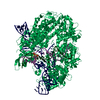+Search query
-Structure paper
| Title | CRISPR-Cas9 bends and twists DNA to read its sequence. |
|---|---|
| Journal, issue, pages | Nat Struct Mol Biol, Vol. 29, Issue 4, Page 395-402, Year 2022 |
| Publish date | Apr 14, 2022 |
 Authors Authors | Joshua C Cofsky / Katarzyna M Soczek / Gavin J Knott / Eva Nogales / Jennifer A Doudna /   |
| PubMed Abstract | In bacterial defense and genome editing applications, the CRISPR-associated protein Cas9 searches millions of DNA base pairs to locate a 20-nucleotide, guide RNA-complementary target sequence that ...In bacterial defense and genome editing applications, the CRISPR-associated protein Cas9 searches millions of DNA base pairs to locate a 20-nucleotide, guide RNA-complementary target sequence that abuts a protospacer-adjacent motif (PAM). Target capture requires Cas9 to unwind DNA at candidate sequences using an unknown ATP-independent mechanism. Here we show that Cas9 sharply bends and undertwists DNA on PAM binding, thereby flipping DNA nucleotides out of the duplex and toward the guide RNA for sequence interrogation. Cryogenic-electron microscopy (cryo-EM) structures of Cas9-RNA-DNA complexes trapped at different states of the interrogation pathway, together with solution conformational probing, reveal that global protein rearrangement accompanies formation of an unstacked DNA hinge. Bend-induced base flipping explains how Cas9 'reads' snippets of DNA to locate target sites within a vast excess of nontarget DNA, a process crucial to both bacterial antiviral immunity and genome editing. This mechanism establishes a physical solution to the problem of complementarity-guided DNA search and shows how interrogation speed and local DNA geometry may influence genome editing efficiency. |
 External links External links |  Nat Struct Mol Biol / Nat Struct Mol Biol /  PubMed:35422516 / PubMed:35422516 /  PubMed Central PubMed Central |
| Methods | EM (single particle) |
| Resolution | 2.5 - 3.3 Å |
| Structure data | EMDB-24817, PDB-7s36: EMDB-24818, PDB-7s37: EMDB-24819, PDB-7s38: EMDB-24823, PDB-7s3h: |
| Source |
|
 Keywords Keywords | HYDROLASE/RNA/DNA /  DNase / DNase /  complex / complex /  ribonucleoprotein / genome editor / HYDROLASE-RNA-DNA complex / HYDROLASE/RNA / HYDROLASE-RNA complex ribonucleoprotein / genome editor / HYDROLASE-RNA-DNA complex / HYDROLASE/RNA / HYDROLASE-RNA complex |
 Movie
Movie Controller
Controller Structure viewers
Structure viewers About Yorodumi Papers
About Yorodumi Papers












